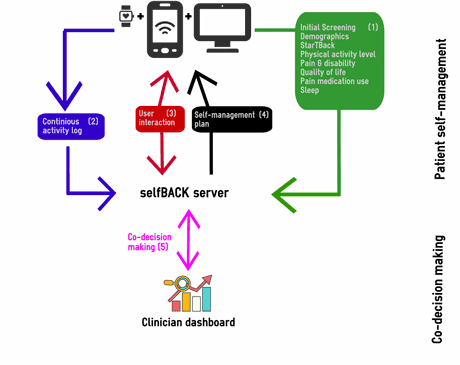by Kerstin Bach, Paul Jarle Mork and Agnar Aamodt
A new Horizon 2020 research and innovation project will start the development of the SELFBACK decision support system for self-management of low back pain in January 2016.
Low back pain is a common reason for activity limitation, sick leave, and disability. It is the fourth most common diagnosis (after upper respiratory infection, hypertension, and coughing) seen in primary care [1]. An expert group concluded that the most effective approach to manage non-specific low back pain is to discourage bed rest, to use over-the-counter pain killers in the acute stage if necessary (e.g., to be able to sleep), reassure the patient about the favourable prognosis, advise the patient to stay active, and advise strength and/or stretching exercise to prevent recurrence [2].
In January 2016 a new project funded by the European Commission’s Horizon 2020 research and innovation programme will start the development of the SELFBACK decision support system for self-management of low back pain. The consortium includes the Norwegian University of Science and Technology (coordinator), the University of Glasgow and the Robert Gordon University in Aberdeen from the UK, the SMEs Kiolis from France and Health Leads from the Netherlands as well as the National Research Centre for the Working Environment in Denmark and the University of Southern Denmark.
Self-management in the form of physical activity and strength/stretching exercises constitute the core component in the management of non-specific low back pain; however, adherence to self-management programs is poor because it is difficult to make lifestyle modifications with little or no additional support. Moreover, the way the self-management advice is presented, and whether the advice is followed up by reinforcement have substantial impact on adherence to a self-management plan and progress of symptoms. In the SELFBACK project we will develop and document an easy-to-use decision support system to facilitate, improve and reinforce self-management of non-specific low back pain. The decision support system will be conveyed to the patient via a smart-phone app in the form of advice for self-management. Even though there are about 300 pain-related apps are available on the market, to the best of our knowledge, none of these apps have documented effects by scientific publications and none include an active decision support system. In contrast, we will document the effectiveness of the SELFBACK decision support system by conducting a nine-month randomized control trial.
The SELFBACK system will constitute a data-driven, predictive decision support system that uses the Case-Based Reasoning (CBR) methodology to capture and reuse patient cases in order to suggest the most suitable activity plans and goals for an individual patient. Based on personal preferences and clinical guidelines, the SELFBACK system will guide patients to adjust their lifestyle in order to optimize their management of low back pain, based on patient’s activity data collected using a wristband. The incoming data will be analysed to classify the patient’s activities and matched against the proposed activities in order to follow-up and advise the patient. The challenge of the data analysis is activity pattern detection, and matching it against existing patient profiles in order to suggest activity goals aiming at the most favourable outcome for the patient. Therefore we will enrich the data stream and the resulting patterns with the patient's symptom state, symptom progression and goal-setting.

Figure 1: SELFBACK data and decision process model.
Figure 1 gives an overview of the SELFBACK proposed data and decision process model that contains five processing modules, of which four modules target self-management by the patient while the fifth module targets the possibility for co-decision making between the patient and a clinician.
The initial screening module (1) acquires basic patient data, which is sent to the SELFBACK server. This data will be collected through a webpage and will provide the starting point for assessing the patient's status and for running the self-management planning module (4) for the first time. The plan for self-management will be updated and revised as more patient data is added. The activity logging module (2) runs continuously since it provides data from the wristband regarding the patient's physical activity and sleep patterns. The main goal of this module is to verify whether the patient follows the suggestions in the recommended plan (e.g., for physical activity). As for the initial screening data, the activity log data is also sent to the server, and becomes input to the periodic run of the self-management planning module (4). The user interaction module (3) is basically a question/answering module, typically initiated by the patient when using the SELFBACK app and browsing through the given information.
Overall, the aim of the SELFBACK system is to solve the problems of reinforcement and adherence to a self-management plan by offering an evidence-based system that allows personalized follow-up and advice to the patient.
Link:
SELFBACK project: http://research.idi.ntnu.no/selfback/
References:
[1] P. Wändell et al.: “Most common diseases diagnosed in primary care in Stockholm”, Sweden, in 2011. Fam Pract 30:506-513, 2013.
[2] M. van Tulder et al.: “Chapter 3. European guidelines for the management of acute nonspecific low back pain in primary care. Eur Spine J 15:s169-s191, 2006.
Please contact:
Kerstin Bach, Paul Jarle Mork, Agnar Aamodt
Norwegian University of Science and Technology
E-Mail:











